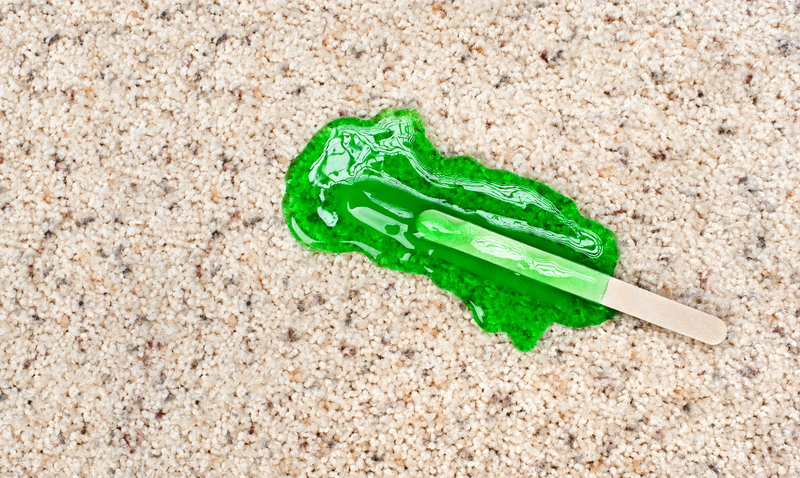Vanquish Grease: Streamlined Guide to Clean Enamel Oven Trays
Posted on 17/06/2025
Vanquish Grease: Streamlined Guide to Clean Enamel Oven Trays
Oven cleaning is often one of the most dreaded kitchen chores. However, when it comes to enamel oven trays, proper maintenance can make the difference between effortless meal prep and a lingering odor of burnt food. Whether you're a seasoned chef or a home-cooking enthusiast, this comprehensive guide will empower you to completely vanquish grease from your enamelware and keep your oven trays pristine.
Why Focus on Enamel Oven Tray Cleaning?
Enamel oven trays have become increasingly popular due to their sleek appearance, durability, and superior heat resistance. Yet, they aren't immune to the notorious buildup of grease and food residue. Over time, that greasy residue not only affects taste and quality in your food but can also shorten the lifespan of your enamel cookware.
- Enhanced Taste: Food tastes better on a clean tray without old flavors seeping in.
- Hygienic Cooking: Eliminating bacteria that thrive on grease and crumbs ensures healthier meals.
- Tray Longevity: Preventing stubborn stains and rust increases your tray's lifespan.
- Efficient Baking: A spotless tray aids in even heat distribution.

Common Challenges with Cleaning Enamel Oven Trays
No matter how careful you are, grease and burnt-on food tend to build up on enamel oven trays over time. Some common cleaning obstacles include:
- Stubborn baked-on grease that resists simple wiping.
- Scratching risk when using abrasive tools.
- Unpleasant odors lingering after multiple cooking sessions.
- The potential to chip or damage the enamel surface with incorrect cleaning methods.
Fortunately, the right know-how and cleaning strategies can help you vanquish every trace of grease without damaging your beloved ovenware.
Essential Supplies for Cleaning Enamel Oven Trays
Before you embark on the cleaning journey, make sure you have all the necessary supplies. Here's what you'll need:
- Mild Dish Soap
- Baking Soda (for tough stains and deodorizing)
- White Vinegar (for natural degreasing)
- Non-scratch Sponges or Soft Bristle Brushes
- Microfiber Cloths
- Rubber Gloves (to protect your hands)
- Plastic Scraper (optional for stubborn residue)
- Hydrogen Peroxide (for difficult cases)
Tip: Always avoid metal scouring pads or harsh abrasives, as these can chip or damage the enamel surface.
Step-by-Step Guide to Vanquishing Grease From Enamel Oven Trays
1. Initial Preparation: Safety First
Allow your enamel oven tray to cool completely before cleaning. Wearing rubber gloves protects your hands from grease and cleaning agents.
2. Soak to Loosen Grease
- Fill your sink or a large basin with warm water and add a generous dash of dish soap.
- Submerge the oven tray fully for at least 30 minutes. For heavy residue, extend soaking time up to 2 hours.
- This soaking process softens stubborn grease and makes it easier to wipe away.
3. Gentle Scrubbing
- Use a non-scratch sponge or soft brush to gently scrub the tray's surface.
- Pay special attention to the corners and edges, where buildup tends to collect.
- For particularly stuck-on bits, try a plastic scraper or the edge of a soft spatula.
- Rinse thoroughly with warm water.
4. Tackling Stubborn Grease With Baking Soda and Vinegar
If grease remains after the initial wash, move on to the baking soda and vinegar method:
- Sprinkle baking soda generously over the tray's greasy spots.
- Spray or drizzle white vinegar to create a sizzling reaction that helps break down oil and grime.
- Let it sit for 10-15 minutes before scrubbing gently with your sponge or brush.
- Rinse thoroughly and dry with a microfiber cloth for a gossip-worthy shine.
5. Dealing With Persistent Stains: Hydrogen Peroxide Paste
Still noticing tough stains? Hydrogen peroxide can be safely used on most enamels for extra cleaning power (do a spot test first):
- Make a paste of baking soda and hydrogen peroxide.
- Apply to stained areas and allow to sit for up to 30 minutes.
- Gently scrub and rinse thoroughly.
6. Drying and Polishing
- Dry the tray immediately with a clean microfiber cloth to avoid water spots or rust on any exposed edges.
- For an extra polished look, buff the surface gently.
Eco-Friendly Tips & Green Cleaning Recipes for Oven Trays
If you prefer a more eco-conscious approach, here are some natural cleaning alternatives for your enamel oven trays:
- Lemon and Baking Soda: Cut a lemon in half, dip in baking soda, and rub the tray for a fresh citrus clean.
- Salt Scrub: For gentle abrasion, use kosher salt with a damp cloth to scrub away stains.
- Steam Power: Place your oven tray in the oven with an oven-proof bowl of water and heat at 200?C for 20 minutes. Steam helps loosen baked-on grease.
These methods are tough on grease but kind to the planet.
Top Mistakes to Avoid When Cleaning Enamel Oven Trays
- Using metal scourers that scratch and chip the enamel coating.
- Soaking trays for too long, which may lead to rust on exposed steel edges.
- Cleaning while the tray is hot, which can lead to thermal shock and cracking.
- Using bleach or harsh chemicals that weaken the enamel overtime.
- Skipping the dry and polish step, causing water spots to form.
Steering clear of these errors will keep your oven tray grease-free and in top condition for years.
How to Keep Enamel Oven Trays Clean - Handy Maintenance Tips
Regular maintenance minimizes time spent on laborious deep cleans and helps vanquish grease before it becomes a problem. Here are the best practices for ongoing enamel oven tray care:
- Wipe immediately after use while the tray is still warm (but not hot!), using a damp cloth to remove fresh spills.
- Use parchment paper or silicone baking mats to prevent direct food contact and sticky residue.
- Always hand wash your enamel trays instead of using the dishwasher, as harsh detergents can dull the finish.
- Store trays dry and stacked with paper towels between them to prevent scratching.
- Set a regular deep-clean schedule, especially if you cook fatty foods often.
Tip: Address spills and splatters as soon as possible to prevent them from hardening or carbonizing.
Frequently Asked Questions on Enamel Oven Tray Cleaning
Can you use oven cleaner on enamel oven trays?
Most commercial oven cleaners contain harsh chemicals and caustic agents that can damage the enamel's glossy surface. Avoid them unless the product specifically states it's safe for enamel cookware. Gentler DIY solutions are often more effective without the risk.
What should you do if your enamel tray develops chips?
Small chips can be sanded smooth and sealed with food-safe enamel repair kits to prevent rust. However, severely chipped trays should be replaced to ensure food safety and optimal performance.
Can you clean enamel oven trays in a dishwasher?
It's better not to use the dishwasher. High temperatures and strong detergents can cause the enamel layer to lose its lustre or even crack over time. Hand washing is best for maintaining tray appearance and durability.
How often should you deep clean your enamel oven trays?
For frequent cooks, aim to deep clean every 2-4 weeks. Occasional users can get away with a monthly cleaning routine. Wipe up spills after every use to prolong intervals between deep cleans.
How do you remove burnt-on food without scratching?
Soaking the enamel oven tray in a warm soapy solution, then using a non-scratch sponge or plastic scraper, usually loosens burned residue. Avoid metal implements and let time do the work if the mess is stubborn.
Professional Tips for Enamel Oven Tray Longevity
- Avoid abrupt temperature changes. Always let trays cool gradually before washing.
- Never use sharp knives or metal utensils directly on enamel surfaces to prevent cutting the glaze.
- Regularly inspect trays for hairline cracks or chips. Early repair can prevent major issues later.
- Line trays for roasting particularly sticky or fatty foods like chicken wings or cheese-based dishes.

Benefits of Pristine Enamel Oven Trays
Why go to all this effort to vanquish grease and keep those enamel trays spotless?
- Improved Cooking Results: Even heat distribution means flawless browning and roasting.
- Long Term Savings: Regular cleaning and maintenance reduce the need for replacement trays.
- Enhanced Kitchen Aesthetic: Shiny, grease-free trays are a joy to cook with and look stunning when serving guests.
- Healthier Meals: Eliminate hidden grease and lingering food debris for pure, clean cuisine every time.
Conclusion: Make Grease a Thing of the Past
With these expert cleaning techniques and maintenance tips, you can vanquish grease from your enamel oven trays for good. A little consistent effort and the right methods make it easy to keep kitchen tasks manageable and your cooking experience top-notch. Reap the rewards of healthier meals, beautifully roasted dishes, and stress-free oven maintenance--your future self (and your taste buds) will thank you!
Ready to take action? Try these methods today to rediscover just how sparkling clean and effective your enamel oven trays can be.




